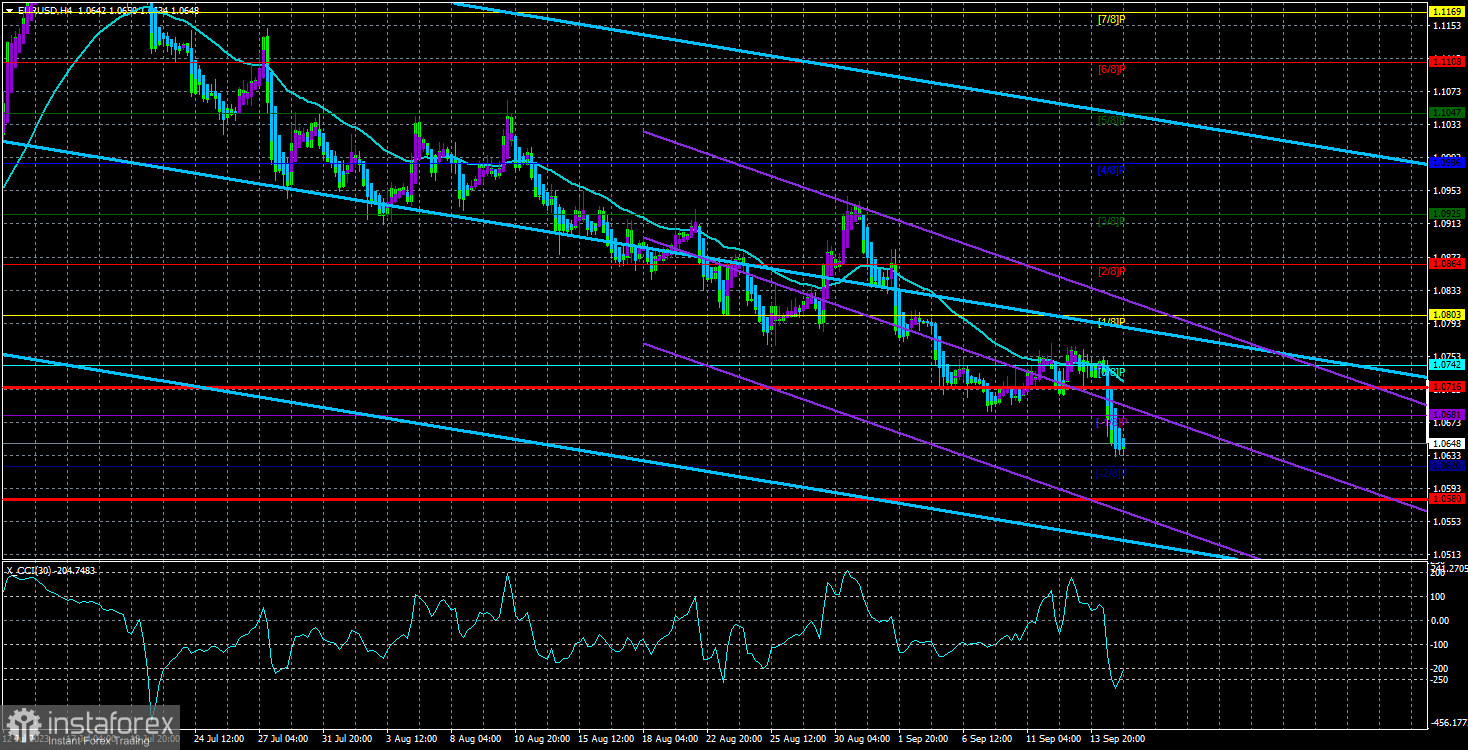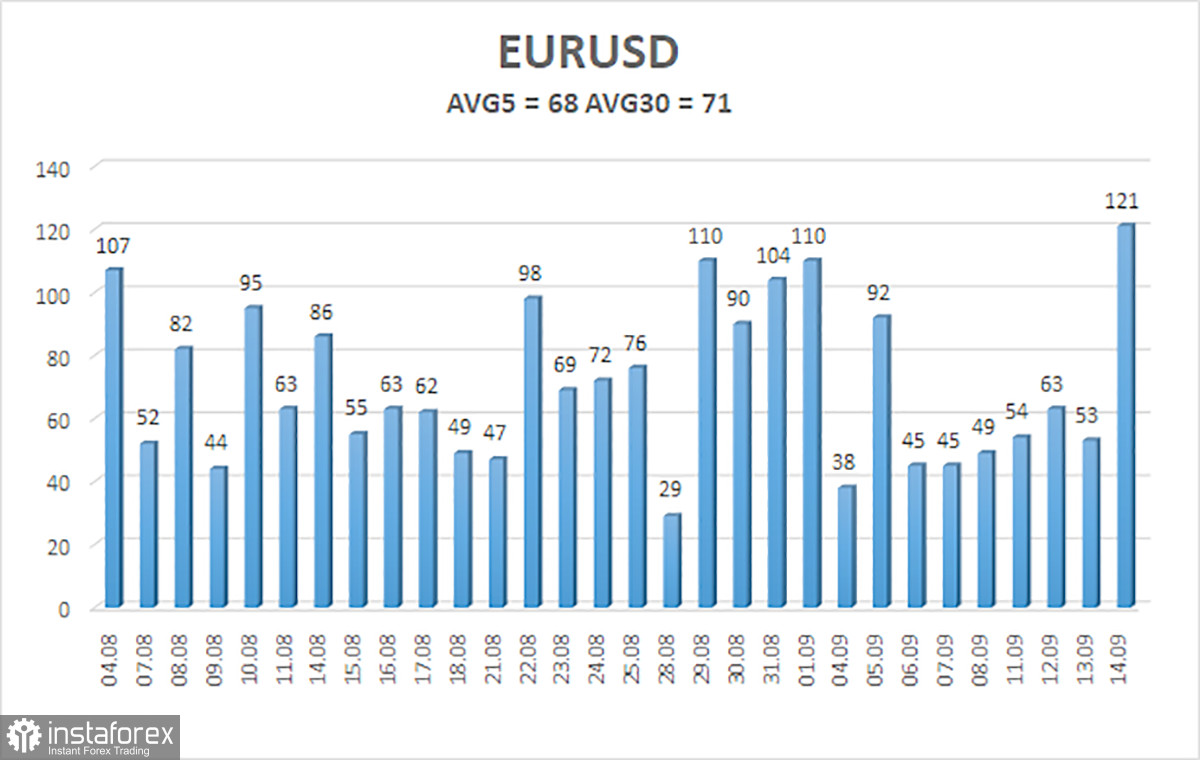
The EUR/USD currency pair sharply and quickly resumed its downward movement during the penultimate trading day of the week. We had openly anticipated an upward correction during the past few days, but the market was not ready for such a development. Volatility was low, and there were no trend movements even within the day. Therefore, there were high hopes associated with Thursday, which could have allowed us to expect either a trend continuation or the start of a correction. As we can see, the market chose the first option, and we cannot blame it for being illogical.
Let's start with what we've talked about many times already. All ECB rate hikes have already been priced in by the market long ago, just like with the Fed. The EU economy is much weaker than the US economy. The ECB rate is lower than the Fed rate and will remain so. Therefore, there are no grounds for the euro to rise. Technical correction—sure, but, as we can see, even with it, certain problems arise. Thus, the market reacted to yesterday's ECB meeting results. Even with a rate hike, the market understands that the "end moment" is near. Okay, the rate was raised in September, which can be a significant point. What's the difference between this scenario and the one with a pause in September and a rate hike in October? The ECB is preparing for the end of tightening in any case, which means there are no more reasons to buy the euro. However, there were a few reasons to buy it even before.
In the 24-hour timeframe, the price approaches the Fibonacci level of 38.2%, which we have repeatedly mentioned as a target. If you remember, several months ago, we said that the pair would return to the 1.05–1.06 range. Now, it needs to break through the level of 1.0609 confidently, and then the euro may have the potential to fall to parity with the dollar.
Christine Lagarde did not alleviate the market's concerns.
To analyze the results of the ECB meeting, we should start with the beginning of the decline, which was exactly when the market learned about the rate hike, not during Christine Lagarde's speech. This means it was not Lagarde's rhetoric that caused the euro's decline but rather the decision to raise the key rate. Yes, this looks strange because, normally, a tightening of monetary policy leads to an appreciation of the national currency. But as we have often said, we expected the euro to fall regardless of the fundamental background. It had become overbought and unreasonably expensive recently.
During the press conference, Mrs. Lagarde "left the door open" for further tightening, but the market didn't seem to believe her much. If ECB representatives have been talking for two months about the inexpediency of a new rate hike, it is obvious that the end is near. Therefore, it didn't matter whether the ECB raised the rate in September or not. We expected a slight rise in the euro, followed by a resumption of the decline. The market decided differently and resumed selling even without a correction. The ECB confirmed yesterday that it is ready to fight high inflation for several years. If tightening ends by the end of the year (and there are only two meetings left), the rate won't have time to rise to the levels that would bring inflation back to 2% for at least a year. This means that the ECB is also concerned about a recession and is not ready to hurt its economy to reduce inflation by 1%.
This is the main difference between the ECB and the Fed. The Federal Reserve can raise rates as high as it wants based on a strong economy. Inflation has increased in the last two months; therefore, the Fed will raise rates another time or two. All of these factors support the US dollar, not the euro. Therefore, as before, we believe the euro will continue to fall.

The average volatility of the EUR/USD currency pair for the past five trading days as of September 15 is 68 points and is characterized as "medium." Therefore, we expect the pair to move between the levels of 1.0580 and 1.0716 on Friday. An upward reversal of the Heiken Ashi indicator will indicate a new attempt to correct upward.
The nearest support levels:
S1 - 1.0620
The nearest resistance levels:
R1 - 1.0681
R2 - 1.0742
R3 - 1.0803
Trading recommendations:
The EUR/USD pair has resumed its southward movement. It is currently advisable to stay in short positions with targets at 1.0620 and 1.0580 until the Heiken Ashi indicator is reversed upwards or until a confirmation above the moving average. Long positions can be considered if the price consolidates above the moving average with targets at 1.0803 and 1.0864.
Explanations for the illustrations:
Linear regression channels - help determine the current trend. If both channels point in the same direction, the trend is currently strong.
The moving average line (settings 20.0, smoothed) - determines the short-term trend and the direction in which trading should be conducted.
Murray levels - target levels for movements and corrections.
Volatility levels (red lines) - the likely price channel in which the pair will move over the next day based on current volatility indicators.
CCI indicator - its entry into the overbought zone (above +250) or oversold zone (below -250) indicates that a trend reversal in the opposite direction is approaching.





















